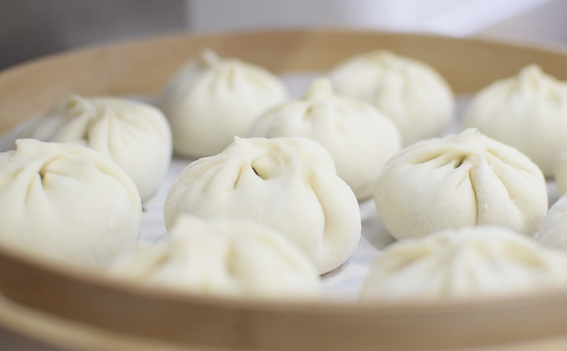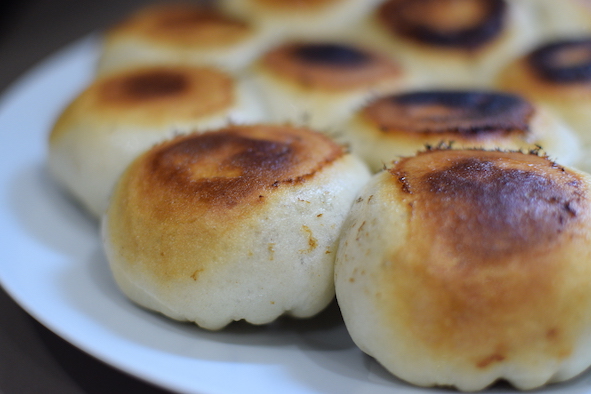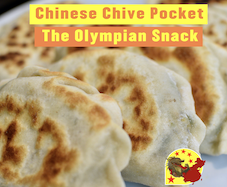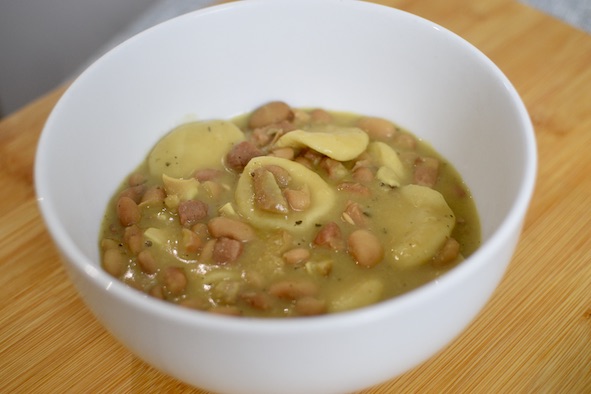How to Make Baozi-包子 from scratch: Steamed and Fried

Delicious Steamed Baozi-包子
Table of Contents
1. Is Baozi a dumpling?
Baozi can be considered a dumpling since it is a dough wrapped around a filling and it can be boiled, steamed or fried.
1.1. Don’t confound Baozi and Jiaozi
There are few fundamental differences between the 2 types:
1) Because Baozi and Jiaozi are wrapped in dissimilar ways, they have different shapes. Baozi has a round shape, while Jiao Zi is like an ear or an ancient silver ingot;
2) They are cooked differently as well. Jiao Zi can be boiled, steamed or pan fried, while Baozi is normally steamed or pan fried, but never boiled;
3) Normally, people need to let the flour rise for Baozi wrap, but they don’t need for Jiao Zi.

饺子-Jiaozi 
包子-Baozi
1.2. Types of Baozi
They are differentiated depending on few factors:
· Skin wrap: There are fully fermented, half fermented, not-fermented and half-cooked skin wraps.
· Filling: there are sweet and savoury flavours. For example, sweet flavoured Baozi can have read bean, brown sugar, and butter and cream fillings etc. Savoury flavour Baozi has even more choices. Indeed, it can be pure meat, pure vegetable, or a mix of both fillings.
· Way of cooking: There you have steamed, pan fried, or baked Baozi.
1.3. History of Baozi

Baozi-包子 has a long history of almost 1800 years. Hence, Chinese have developed many idioms related to it. Below are just some, you might hear if you travel to china:
– 肉包子打狗有去无回 (Throw a meat-stuffed bun at a dog. One can never get back what he gives away).
– 包子有馅不在褶 (The appearance is not very important – Similar to Baozi. The taste of what is inside is more important than the outside appearance) .
– 哑巴吃包子心里有数 (When a mute person eats Baozi, he knows how many he has eaten, even though he cannot speak. This is used to illustrate someone who knows a situation quite well while saying nothing).
2. Ingredients: For 5/6 people
– 500g of Bread flour
– 330ml of warm water
– 5g dry fast acting yeast
– 500g shredded turkey tights (or other meat)
– 300g of dill vegetable
– 3 spring onions
– 1 egg
– ½ tea spoon of Chinese 5 spices
– 1 tea spoon of salt
– 1 ½ table spoon of Chinese rice wine
– 3 table spoon of soy sauce
– 1 tea spoon of chicken powder
– 1 table spoon of oyster sauce
– 2 table spoon sesame oil
In the recipe given below, we will learn how to make the most common kind of Bao zi, which is the one with fermented skin wrap, with ground meat and vegetable mixture fillings.
3. Choose the right flour
The first key step is to choose the right kind of flour. The ideal texture of fermented skin Bao Zi is a bit soft and loose. Hence, plain flour/all purpose flour is the best choice comparing with the strong bread flour.
The second important factor is the ratio of the mixture.

4. What is Bao flour made of? – Make a dough

– 500g of plain flour, 300ml of lukewarm water, 5g of fast active dried yeast and 3g of sugar will make the dough rise fast and perfectly within 40 minutes to an hour.
– Add 10 to 20ml of vegetable oil into the mixture is good to make the dough smooth, and it also makes the skin looks better after cooking.
– If you knead the dough by hand, I suggest that you knead for at least 10 minutes until the dough is smooth and not easy to break down. The process of fermentation is the same as that of making a bread.
4.1. Let the dough rest for 2 hours before use
When the dough has doubled in size, it is ready to be turned into skin wraps. The dough does not need to be knocked down. However, after wrapping and shaping the Bao zi, you need to let them set for 20 to 30 minutes before cooking them. This is a very important step, as during the process of rolling the skin and making the Baozi, a lot of air evaporated. This setting process will let the yeast reproduce airs in the skin.
5. Prepare the Meatball Filling
In this recipe we use shredded turkey tight about 7%fat
Any kind of meat can be used such as chicken, beef, pork, lamb. Chinese like to use pork only because the meat is affordable and readily available all year round. The recipe; as many other things you will discover about the Chinese culture, is not as stringent as elsewhere. Chinese take lots of liberties with how they manipulate ingredients. That’s one of the biggest differences you will discover about China, as a foreigner. The concept of measurement is as foreign to Chinese, as the use of terms such as “a little bit of this, some of that” by Chinese is alien to foreigners.
As such, for this recipe, even if I give you a guideline, you can use your imagination and liking to add more ingredients to this dish. For example, you can also add whatever vegetables you feel like (e.g. Chinese cabbage, any green and leafy vegetables).
5.1. For best result:
To have a juicy filling, add ginger, water or mix of chicken, beef or vegetable stocks into the ground meat. Especially if you use beef as their meat tend to be dry and tough compared with other kind. Normally, you can add 50 to 60ml liquid into 500g ground beef. The technic is to add the liquid in three times instead of in one go.
The basic seasonings are salt, pepper, and a bit vegetable oil. On top of this, you can add any of soy sauce, Chinese five spices powder, ginger, onion or spring onion, sesame oil, oyster sauce or Chinese cooking rice wine as you like
5.2. Add to the turkey :

– 1 egg
– Half tea spoon of Chinese 5 spices
– 1 teaspoon of salt
– 1 table spoon of Chinese rice wine
– 2 table spoons Light soy sauce (reduced sodium)
– 1 tea spoon of chicken powder
– 1 table spoon of Oyster sauce
– 3 table spoons of sesame oil
Mix the turkey and the other ingredient very well. Stir in one direction only. At the beginning, the mixture will feel loose. The more you mix the ingredients together the firmer the whole component become.
Put the seasoned and well mixed meat in the fridge for 30 minutes while you are preparing the vegetables.
Next we chop the vegetables.
6. Prepare the Vegetables
Here, I list some common combinations for you to consider. Pork with Chinese cabbages or normal cabbages; beef with celery or onions, beef or lamb with carrots; chicken with mushrooms, or zucchini squash with any of the meats.
6.1. Handle your vegetables
You need to squeeze some liquid out of those vegetables before mixing with the meat. For vegetables like cabbages and celery, you need to:
· boil them for a minute in the boiling water;
· cool down the boiled vegetables;
· chop them finely;
· use hands or muslin cloth to squeeze out most of the water from the chopped vegetables.
For vegetables like zucchini, you don’t need to boil them, but you will still squeeze liquid out of them before mixing with the seasoned ground meat. Vegetables like onion and carrot do not need to be squeezed out, but require a little bit of oil. The oil will seal the vegetables from releasing too much liquid when mixing with the meat.
6.1.1. Today I use dills (about 300g) and spring onion
Start cutting your spring onions then your dill. Finely chop the dills.
When I handle my meat or vegetable, I like to use a Chinese knife. This is not compulsory and I understand people not familiar with that kind of knives might be scared of using it. It is actually not dangerous as long as you handle with a certain care (you can check how I handle the knife in the cooking instruction for this recipe).
7. Mix the Meat Combination and Chopped Vegetables together
In terms of the portion between the amount of ground meat and vegetables, there are no strict rules. It dependents on your personal preferences. But generally, a 5:3 ratio between meat and vegetables makes for a perfect final taste.
Finally, remember! Always mix the vegetables and the meat right before you wrap the Bao zi. Do not mix and let them set for too long before you make the dish. This is to prevent the vegetables from releasing too much liquid which makes it difficult to seal the Bao zi.

8. Use half of the dough
For steam buns
Lengthen the dough on a board so you can cut it in mini doughs. As mentioned early the size of the meat bun you want will decide how big you cut your dough to form your mini doughs. On average a mini dough will be about 10-15g.
After you cut all your dough in mini doughs, mix them with a bit of dusting flour.
9. Making of the buns: you need a small size rolling pin
Add a bit of dusting flour to one of your mini doughs, then press it flat on the surface. Use your left hand to hold the flat dough. Use your right hand to hold the rolling pin.
The perfect size of a Bao Zi is about a size and shape of a small onion which is about 5 to 6cm in diameter. Therefore, the wrap needs to be a circle with about 9 to 10cm diameter. It is also important to keep the center of the wrap a bit thicker than the edge, as the filling needs to be put in the center.

Keep pressing on the dough with your right hand; while turning the dough to the left. That way you get a flat wrap. Make the edge a little thinner than the inside.
10. Add your filling then close the wrap
10.1. Appearance for appetite
There is a Chinese saying that “包子有馅不在褶” (the folding of the Bao zi is not as important as the filling), which means that you should not judge a person from his/her appearance, or the substance is more important than the form. However, we do want our Bao zi not only to taste great, but also look good.
10.2. How do you wrap a Baozi?
Add about a full table spoon of your filling in the centre. With your thumb and index & middle fingers of the right, hand lock the wrap, while moving the wrap in circle with your left hand. At the end tie up the wrap to fully form the bun. The last fold shall seal all folds together without leaving any gap. A good-looking Bao Zi needs at least to have 15 to 18 folds. Less folds will affect the shape of your product. It also indicates that either the filling is not enough or the folds are too big which leaves the top of the bao zi with a big lump of dough. The more the filling, the better the taste; as long as you can wrap them up tightly. A beginner can start from less filling and add more once master the technic of wrapping up.



The Perfect shape 
Let all the buns rest for 25 minutes before cooking.
11. Repeat steps 5,6,7 with the remaining half of your dough
For fried buns
The reason why I separated the dough in half is for convenience purpose, but also because half of the buns will be steamed and the other half fried. Depending on your taste, you can cook all in one way. In our family, some like fried, others like steamed.
Steps 8 & 9 can be done simultaneously
12. How do you steam Baozi?
12.1. Tip for steamed Baozi

If you want to steam them, it is best you put a steamer paper at the bottom of a bamboo steamer. This will make it much easier to get the bao zi out afterwards.
Another tip is that, you do not put them too close to each other in the steamer. Leave about 2 to 3cm distance in between. As the skin continue to rise during cooking time, if you don’t leave enough space between them, all your Bao zi will stick. It is better you cook them in two batches than fill them all up at once.
For that you will need a big wok and bamboo steamer and steamer paper.
12.2. Process – How long do you steam baozi?
· Put around 800ml of boiling water in wok on fire.
· Add the bamboo steamer to the wok then the steamer paper.
· Finally add your buns. (Make sure your buns do not touch the edge of the bamboo steamer as they will stick to it.)
· Cover the whole content using the bamboo steamer cover
· Set the fire a mid-high strength
Cook for 10-12 minutes, until the steam comes out. Please do not open the lid immediately after you turn off the fire. The skin of the Baozi will shrink if it cools down immediately. Let them set in the steamer for another 3 minutes before open the lid.
· Once you open the lid. If the doughs do not shrink back then ITS SUCCESSFUL.
13. Pan fry the other half
13.1. Tip for fried Baozi

If you choose to pan fry them, you can use a non-stick frying pan, coat it with a little bit oil, turn on the fire at medium level, arrange the Bao zi in the frying pan from outside circle to inside circle. The Bao zi do not need to be set apart in the frying pan, you can put them together without distance.
13.2. Process
– Pour some oil in a frying pan,
– Add your buns to fill the pan (the buns can touch the edge of the frying pan)
– Turn on the fire to medium-low
– Cover for about 3 minutes
– After 3 minutes ad 50 ml of cold water, then cover
cook until the water completely evaporates. When you can hear a sizzling sound in the pan, it means the water has gone.
– Leave the Bao Zi in the pan to cook further 3 to 4 minutes, then turn off the fire. Again, don’t open the lid immediately, let it set for another 3 minutes before you open the lid.

14. Sauce for Baozi
Chinese like to dip their Bao zi into a sauce made of vinegar, soy sauce and chilli oil. But again, there is no strict rule in terms of what to put into the sauce. My experience is that vinegar is not a good complement for beef or lamb filling. And if your filling is salty enough, soy sauce is not necessary either. Chilli oil or sesame oil? It all depends on your taste.
Now, you have finished all the steps of making Baozi. Congratulations and enjoy!
We Recommend:
How To Cook The Best Olympian Style Chinese Chive Pocket
The Best Coca-Cola Chicken Wing Recipe Ever
Best Kept Secrets Of Delicious Chinese Style Lamb Wrap
The Best Glutinous Rice Balls Recipe Ever Made | 汤圆
This Is How Sea Bream Fish Is Cooked | Special Chinese New Year Edition
The Best Dombré EVER – Caribbean “Pig Ears Dumplings”










